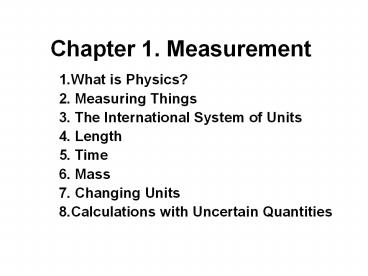Chapter 1. Measurement PowerPoint PPT Presentation
Title: Chapter 1. Measurement
1
Chapter 1. Measurement
- 1.What is Physics?
- 2. Measuring Things
- 3. The International System of Units
- 4. Length
- 5. Time
- 6. Mass
- 7. Changing Units
- 8.Calculations with Uncertain Quantities
2
What is Physics?
- Physics is the study of the basic components
of the universe and their interactions. Theories
of physics have to be verified by the
experimental measurements.
3
Measurement
- A scientific measurement requires
- (1) the definition of the physical quantity
- (2) the units.
- The value of a physical quantity is actually the
product of a number and a unit .
- The precision of the measurement result is
determined by procedures used to measure them.
4
Basic Measurements in the Study of Motion
- Length Our How far? question involves being
able to measure the distance between two points.
- Time To answer the question, How long did it
take?
- Mass Mass is a measure of amount of stuff.
5
The Système International (SI) of units
- The SI, or metric system of units is the
internationally accepted system of units for
measurement in all of the sciences, including
physics. - The SI consists of base units and derived units
(1) The set of base units comprises an
irreducible set of units for measuring all
physical variables (2) The derived units can be
expressed in terms of the base units
6
The SI Base Units
7
- Time One second is the duration of 9.192631770
109 periods of the radiation corresponding to
the transition between the two hyperfine levels
of the ground state of the cesium-133 atom.
8
- Length One meter is the distance traveled by
light in a vacuum in a time interval of 1/299 792
458 of a second
9
- Mass One kilogram is the mass of this thing
- (a platinum-iridium cylinder of
heightdiameter39 mm) - Atomic mass units (u)
10
Scientific Notation
- All Physics quantities should be written as
scientific notation, which employs powers of 10.
The Order of magnitude of a number is the power
of ten when the number is expressed in scientific
notation
11
Example
- Determine the order of magnitude of the following
numbers - (a) A2.3104, (b) B7.8105.
12
Changing Units
- In chain-link conversion, we multiply the
original measurement by one or more conversion
factors. A conversion factor is defined as a
ratio of units that is equal to 1.
For example, because 1 mile and 1.61 kilometers
are identical distances, we have
13
EXERCISE 1
- (a) Explain why it is correct to write
1 min/60 s 1, but it is not correct to write
1/60 1. - (b) Use the relevant conversion factors and the
method of chain-link conversions to calculate how
many seconds there are in a day .
14
EXERCISE 2
- The cran is a British volume unit for freshly
caught herrings 1 cran170.474 liters (L) of
fish, about 750 herrings. Suppose that, to be
cleared through customs in Saudi Arabia, a
shipment of 1255 crans must be declared in terms
of cubic covidos, where the covido is an Arabic
unit of length 1 covido48.26 cm . What is the
required declaration?
15
Density
- The density ? of a material is the mass per unit
volume
16
Calculations with Uncertain Quantities
- Significant Figures Read the number from left to
right, and count the first nonzero digit and all
the digits (zero or not) to the right of it as
significant.
- Significant figures and decimal places are
different - The most right digit gives the absolute
precision, which tells you explicitly the
smallest scale division of the measurement. - Relative Precision is the ratio of absolute
precision over the physics quantity.
17
EXERCISE 3
- Determine the number of significant figures,
absolute precision, relative precision in each of
the following numbers (a) 27 meters, (b) 27
cows, (c) 0.003 429 87 second, (d) 1.970 500
1011 coulombs, (e) 5280 ft/mi.
18
EXERCISE 4
- Suppose you measure a time to the nearest
1/100 of a second and get a value of 1.78 s. - (a) What is the absolute precision of your
measurement? - (b) What is the relative precision of your
measurement?
19
A Simple Rule for Reporting Significant Figures
in a Calculated Result
- Multiplying and Dividing When multiplying or
dividing numbers, the relative precision of the
result cannot exceed that of the least precise
number used - Addition and Subtraction When adding or
subtracting, you line up the decimal points
before you add or subtract. This means that it's
the absolute precision of the least precise
number that limits the precision of the sum or
the difference. - Data that are known exactly should not be
included when deciding which of the original data
has the fewest significant figures. - Only the final result at the end of your
calculation should be rounded using the simple
rule. Intermediate results should never be
rounded.
20
EXERCISE 5
- Perform the following calculations and express
the answers to the correct number of significant
figures. - (a) Multiply 3.4 by 7.954.
- (b) Add 99.3 and 98.7.
- (c) Subtract 98.7 from 99.3.
- (d) Evaluate the cos(3).
- (e) If five railroad track segments have an
average length of 2.134 meters, what is the total
length of these five rails when they lie end to
end?

